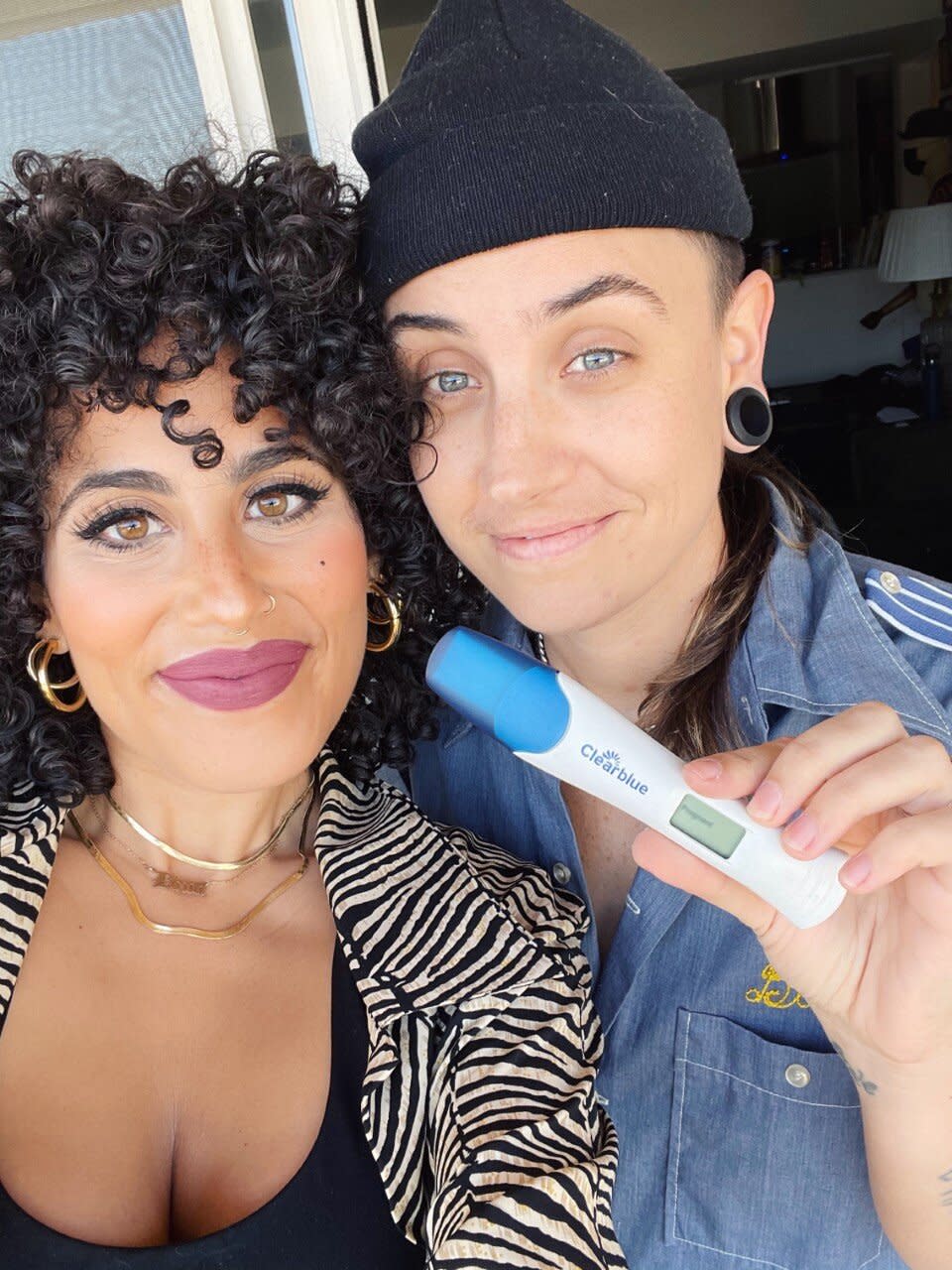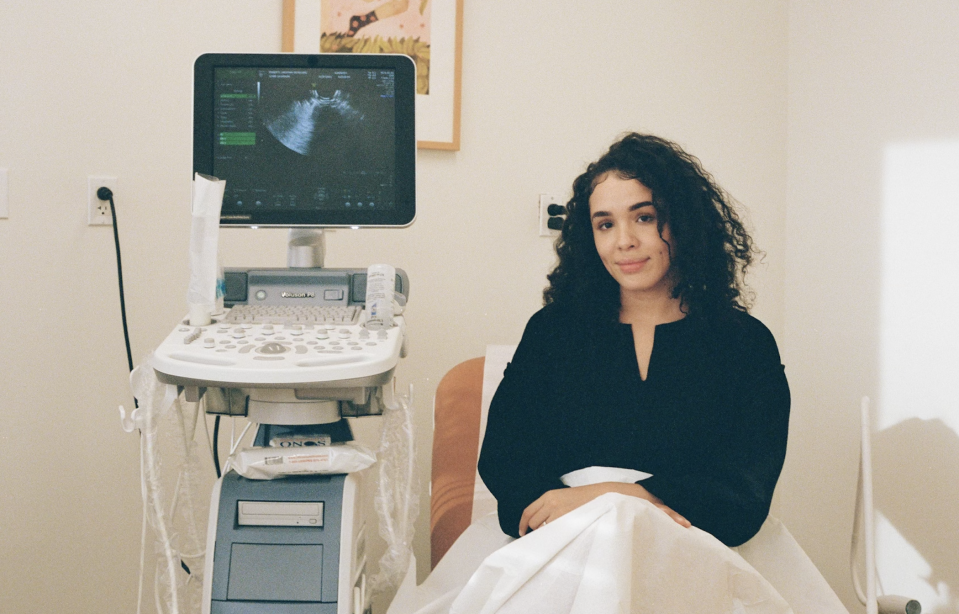Queer Parents Are Over-Charged for IVF-Here's How to Be Prepared
Tragik and Jaewynn started family planning in 2020, and a year and thirty-thousand dollars later, they're expecting their first child in August of this year. The couple's pregnancy journey has been full of love for each other, heartbreak at times, and more bills than they've ever paid in their lives.
"I never imagined for most of my life, especially in my twenties, that I could save up $30K to have a child this way," Tragik tells Parents. The queer Latinx and Black creative couple decided to have a baby, record their journey on YouTube, and move across the country during the pandemic.

Getty Images (1) Art: Jillian Sellers.
The couple decided on reciprocal IVF (RIVF), which is similar to regular IVF in that an egg is fertilized outside of the body (in vitro); in RIVF the embryo is implanted into the other partner. Another name for this is "shared motherhood," because both women get to participate in the pregnancy.
The cost of IVF can easily match a year of college tuition or the price of a new car. This amount of money isn't change in the bank, especially for queer and transgender couples who already face challenges in employment and financial support. According to the Williams Institute at UCLA, LGBTQ people are facing higher rates of unemployment than non-LGBTQ people now during the pandemic.
Already, queer couples face a financial setback when exploring these types of family planning services. It doesn't help that insurance won't cover any fertility treatments for LGBTQ families.

Alanah and Alisha Dixon Alanah and Alisha Dixon
In general, most private and public insurance companies do not offer fertility coverage, and just fifteen states require private insurance to provide some fertility support. New York is the only state Medicaid program that provides any fertility treatment coverage-although IVF or egg freezing are not covered at all.
The only way to get some modicum of insurance coverage for IVF is if you can prove infertility-meaning a couple has to have unprotected, heterosexual sex for a year with no results. And where does that leave a lesbian or gay couple? Or a transgender couple?
Alanah Dixon and her wife Alisha were met with this infertility clause when they first started to plan for a baby, also during the pandemic. The couple was living in New York City and Alanah had just upgraded her insurance to a higher tier with better coverage-a maximum of $30K coverage for fertility treatments. The couple was confident and excited, but their doctor didn't mirror their enthusiasm.
The only way to get some modicum level of insurance coverage for IVF is if you can prove infertility-meaning a couple has to have unprotected, heterosexual sex for a year with no results. And where does that leave a lesbian or gay couple? Or a transgender couple?
"We were not prepared to be told that insurance was going to cover none of it," says Alanah.
Their doctor told them that the only way they could get coverage was if they could prove that they had unprotected heterosexual sex for a year with no results.
"What do you need? Dick pics?" responded Alisha.
"Yes, actually," said the doctor.
They had helped a woman in the past get coverage this way. Through a year-long process of tediously having their friend text them NSFW pictures, and saving those messages, the person was able to play the system. But the doctor didn't recommend this tactic.
The couple decided against playing games with healthcare and insurance. They looked at each other in the doctor's office and knew that they had to start saving.
The out-of-pocket cost for IVF starts in the $15-17K range; the majority is used towards lab costs, equipment, and keeping the eggs in the incubators, Dr. Kristin Bendikson, an LA-based reproductive endocrinologist, tells Parents. Bloodwork and medication are not included in that amount-and can add another few thousand dollars to the total.
There's also the option to add on genetic testing services (an additional few thousand dollars), to analyze the embryo's chromosome composition. This technology looks for any predisposition to disease or genetic mutations that could cause issues later on. It's optional, but recommended for women who are over 35 years old.
"At that age cutoff, they're more likely to have eggs that lead to embryos that are abnormal," says Dr. Bendikson.
At this point, couples may be over $20K into their fertility treatments-and the implantation hasn't even started yet. And this is where the catch-22 arises.
Women are born with all their eggs. As they mature and go through puberty, the numbers start to decline. What's more, is that the quality of the eggs also drops with age, and that makes the chances of a successful pregnancy lower.
This makes it even more challenging for queer couples, who have to wait until they've accumulated the financial means to start this whole process-likely well into their 30s or 40s. Starting egg freezing and fertilization while younger can lead to more successfully fertilized and healthy embryos.

Jaewynn at Kindbody Clinic. Jaewynn.
"The lovely thing about an excess of embryos is that their chances of becoming pregnant don't change as they sit frozen in the cryo-tank," adds Dr. Bendikson. But for many queer and trans couples who are living paycheck-to-paycheck well into their 30s, freezing their eggs in their 20s is the same cost as a year's worth of rent.
New fertility clinics like Kindbody are looking to change that by offering their services at a more affordable cost (still in the tens of thousands). This is where Tragik and Jaewynn, as well as Alanah and Alisha, went to pursue family planning.
"It's like a Disneyland for fertility," says Tragik.
The clinic, which is also where Dr. Bendikson works, offers fertility treatment, family planning, and wellness care-it's boutique women's health meets tech. The concept isn't new; it's just being reinvented with women in mind.
There are therapists on-site to help couples discuss difficult questions that they may not be thinking of. Maya Grobel, a therapist and infertility specialist, helps couples process the reality of genetics and building a family.
"I love the work that I do because I get to hold space for people to think about what all this really means," she says.
If you're thinking about pursuing IVF or family planning after reading these stories, here are four ways to be prepared-with tips from the moms who have been through it.
Research your options.
IVF and RIVF are the most expensive options for family planning. Before jumping straight into in vitro, consider intrauterine insemination (IUI). Dixon and her wife went through IUI for their first pregnancy, and fortunately for them, it worked the first time. Usually, it takes a few tries to have a successful pregnancy through IUI, but even then the highest you pay could be lower than the base price of IVF.
Start saving early.
If you're thinking about pregnancy in the future, start putting aside money as early as you can. This could also mean a meeting with your physician to talk about options and costs so you have a clear picture of what the numbers are.
"Even if it's something you can't afford right now, you can change your financial planning to set you up in the future," says Dr. Bendikson. This also extends to saving your eggs; more and more women are freezing their eggs earlier-and doing so will reduce future costs.
Communicate with your partner(s).
Talking with your partner(s) is the most important way to be prepared for this journey. Starting with family planning, conversations will range from financials to contributions to careers-particularly so during fertility treatment, when there are heightened levels of hormones (literally).
"You're forced to talk about a lot of things. There's so much to unpack throughout the entire process," Dixon says in looking back at the last year. But with that comes a deeper and stronger bond. Both couples I spoke to cited how much this entire process made them into better partners for each other.
Get ready for an emotional rollercoaster.
If there's one sure thing about this entire journey, it's that it won't be easy. Whether it's the insurance nightmares, the hormones, or the unsuccessful attempts, the emotions will be high. Maybe the first insemination won't take, or there will be some surprising news about your body. Whatever it may be, know that it's all part of the ride-of which there's no one right way.
The first implanted embryo for Tragik and Jaewynn didn't take, and coming out of that sadness and depression was challenging, says the couple. But they tried again-and got the good news early on Thanksgiving (by breaking the rules and using an at-home pregnancy test).
In recalling their memory of the successful implantation, they both say the same thing: "We started crying. It was an incredible feeling."

